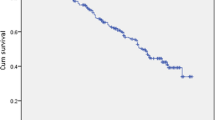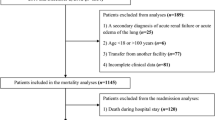Abstract
Congestive heart failure (CHF) constitutes an important public health problem in Italy, evidenced by the high number of hospital admissions each year. Significant inter-hospital as well as inter-ward differences in mortality rates for CHF patients that have been described may, in part, be explained by the differences in the severity of the illness of admitted patients. The goal of this study was to predict 30-day severity-adjusted mortality risk in patients with CHF admitted to wards of a teaching hospital in Siena, Italy, in 1997. A 30-day mortality was determined by linking hospital discharge files with the Tuscany Mortality Registry database. The 3M all patient refined diagnosis related group (APR-DRG) software was used as a risk assessment method. The relationships between death and the following variables were studied by univariate analyses: APR-severity risk, APR-mortality risk, age, sex, length of stay and, discharge ward. Multivariate analysis was also performed to verify the associations between death and those parameters found to be significant by univariate analysis. Unadjusted mortality proportions ranged from 4.3 to 44.0%. Logistic regression analysis demonstrated that APR-mortality risk, length of stay, and discharge ward were significantly and independently associated with 30-day mortality risk in patients with CHF. In summary, 30-day mortality risk varied significantly according to the ward of discharge in an Italian teaching hospital, even after adjustment for severity of illness.
Similar content being viewed by others
References
Health Care Financing Administration. Medicare hospital mortality information 1986, 1987, 1988. HCFA Pub. No. 00647. Washington, DC: US Government Printing Office, 1989.
Iezzoni L. Assessing quality using administrative data. Ann Intern Med 1997; 127: 666–674.
Nante N, Giannuzzi P, Sapia A, Pellegrino P, Isoardi MA, Melli F, et al. Mortalità intraospedaliera DRG specifica: performances di alcuni nosocomi dell'Italia centro-settentrionale (In-hospital mortality DRG related: Performance of different Italian northern hospitals) Annali di Igiene, X, 4 (suppl.2 — Atti 38° Congr.Naz.S.It.I.), 1998: 25.
Nante N, Moirano F, Giusti E, Galanti C, Giuliano G, Taddei M, et al. Mortalità intra ospedaliera DRG specifica in alcuni nosocomi italiani (In-hospital mortality DRG related in different Italian hospitals). Organizzazione Sanitaria 1999; 4: 78–91.
Rosenthal GE, Harper DL, Quinn LM, Cooper GS. Severity adjusted mortality and length of stay in teaching and nonteaching hospitals. Results of a regional study. JAMA 1997; 278: 485–490.
Rosenthal GE, Shah A, Way LE, Harper DL. Variations in standardized hospital mortality rates for six common medical diagnoses: Implications for profiling hospital quality. Med Care 1998; 36: 955–964.
Pine M, Norusis M, Jones B, Rosenthal GE. Predictions of hospital mortality rates: A comparison of data sources. Ann Intern Med 1997; 126: 347–354.
Young WW, Kohler S, Kowalski J. PMC patient severity scale: Derivation and validation. Health Serv Res 1994; 29: 367–390.
Iezzoni L, Moskowitz MA. A clinical assessment of medisgroup. JAMA 1988; 260: 3159–3163.
Gonnella JS, Hornbrook MC, Louis DZ. Staging of disease: A case-mix measurement. JAMA 1984; 251: 637–644.
Fridlin C. Using severity-adjusted data to impact clinical pathways. Healthc Inf Manage 1996; 10: 23–30.
Bilora F, Vettore G, Saccaro G, Barbata A, Dei Rossi C, Petrobelli F. Epidemiologic evaluation of cardiac decompensation and its impact on health cost. Minerva Cardioangiol 1998; 46: 235–239.
Ministero della Sanità. Primi 30 D.R.G. per numerosità delle dimissioni. Anno 1996 (versione D.R.G. 10) — Ricoveri per acuti — Regime ordinario. Italian Health Ministry. The largest 30 DRGs according to hospital discharges during 1996. Available at: URL:http://www.sanita.it/sdo/dati96/dc9605.htm. Accessed 18 September 2000.
3M Health Information Systems. Progetto di valutazione degli APR-DRG su dati di attività ospedaliera italiana (The Italian APR-DRG project). Milano, 1999.
All Patient Refined Diagnosis Related Groups Definition Manual. Wallingford CT, 3M Health information systems, 1995.
Thomas JW, Hofer TP. Accuracy of risk-adjusted mortality rate as a measure of hospital quality of care. Med Care 1999; 37: 83–92.
Dubois RW, Rogers WH, Moxley JH, Draper D, Brook RH. Hospital inpatient mortality: Is it a predictor of quality? N Engl J Med 1987; 317: 1674–1680.
Iezzoni LI, Ash AS, Shwartz M, Landon BE, Mackiernan YD. Predicting in-hospital deaths from coronary artery bypass graft surgery: Do different severity measures give different predictions? Med Care 1998; 36: 28–39.
Alemi F, Rice J, Hankins R. Predicting in-hospital survival of myocardial infarction: A comparative study of various severity measures. Med Care 1990; 28: 762–775.
Iezzoni LI, Shwartz M, Ash AS, Mackiernan YD. Using severity measures to predict the likelihood of death for pneumonia inpatients. J Gen Intern Med 1996; 11: 23–31.
Localio AR, Hamory BH, Sharp TJ, Weaver SL, TenHave TR, Landis JR. Comparing hospital mortality in adult patients with pneumonia: A case study of statistical methods in a managed care program. Ann Intern Med 1995; 122: 125–132.
Spirito R, Musumeci S, Parolari A, Porqueddu M, Dainese L, Agrifoglio M, et al. Surgery of the ascending aorta: The 1984–1995 experience of the cardiac surgery teaching unit in the University of Milan. Multivariate analysis of its risk factors for hospital mortality and reduced long-term survival. G Ital Cardiol 1997; 27: 775–785.
Polanczyk CA, Rohde LE, Philbin EA, Di Salvo TG. A new casemix adjustment index for hospital mortality among patients with congestive heart failure. Med Care 1998; 36: 1489–1499.
McMurray J, McDonagh T, Morrison CE, Dargie HJ. Trends in hospitalization for heart failure in Scotland 1980–1990. Eur Heart 1993; 14: 1158–1162.
Reitsma JB, Mosterd A, de Craen AJ, Koster RW, van Cappelle FJ, Grobbee DE, et al. Increase in hospital admission rates for heart failure in The Netherlands, 1980–1993. Heart 1996; 76: 388–392.
Characteristics of hospitalization of aged patients before and after introduction of the prospective payment (DRG-ROD system). Researchers of the Italian Group of Pharmaco-epidemiology in the Aged. Ann Ital Med Int 1996; 11: 220–227.
Author information
Authors and Affiliations
Rights and permissions
About this article
Cite this article
Nante, N., De Marco, M., Balzi, D. et al. Prediction of mortality for congestive heart failure patients: Results from different wards of an Italian teaching hospital. Eur J Epidemiol 16, 1017–1021 (2000). https://doi.org/10.1023/A:1010841102298
Issue Date:
DOI: https://doi.org/10.1023/A:1010841102298




